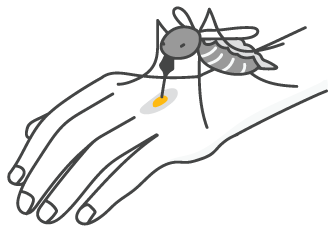Based on a country’s climate and population, different countries are affected differently with vector borne diseases. In India, there are primarily 5 vector borne diseases that are prevalent or were common in India:
1. Dengue Fever
The dengue fever is an extremely common vector borne disease in India, spread through the mosquito bite of the daytime feeder, Aedes aegypti. Thousands of people are affected every year in India, especially during the monsoons.
Just like in most vector borne viruses, the dengue fever too has symptoms like the flu. However, in dengue fever extreme dehydration and loss of blood may occur as well.
Currently, there is no direct cure or vaccination for the dengue fever but one’s condition can be improved and cured through a combination of medical and home treatment. To read more about the dengue fever, its preventions and treatment measures, you can read our dengue health guide here.
2. Malaria
Malaria has a long history in India. In fact, it is still pretty much an epidemic in India. Malaria is spread through the bite of the female anopheles' mosquito, which in turn is a carrier for a parasite called Plasmodium.
The World Health Organization (WHO) data shows that 219 million people were infected with malaria and 435,000 died worldwide from the disease just in 2017. While India saw 429,928 cases of malaria and 96 malaria deaths in 2018! (Source: National Vector Borne Disease Control Programme)
Although India hopes to be malaria-free by 2030, currently almost 87% of malaria cases in South-East Asia are from India itself. The same can be currently treated with proper medical treatment.
3. Zika Virus Infection
You’ve probably heard about the zika virus and have read much about it while traveling internationally at airports (before COVID-19 came into the spotlight of course!).
India’s first case of the same was back in 2018 after which the central health authorities undertook various programs for testing – it was then found that around 157 people were infected, and tested positive.
Surprisingly, the Zika Virus is caused by the same mosquito that causes dengue, chikungunya and yellow fever. It too bites during the daytime.
However, it is not life-threatening, but it is said to lead to severe defects for newborns if a pregnant woman is infected with the same.
The good news however is that, currently zika virus is quite rare in India.
4. Japanese encephalitis
Less heard of but actually common in India, especially in kids between three to six years old. The Japanese encephalitis affects both humans and animals, and is spread through vectors like mosquitoes, pigs and water birds. It is the major cause of encephalitis (inflammation of one or more parts of the brain) all over Asia.
Just last year, more than 150 infants and children died due to this viral disease in Muzaffarpur, Bihar after eating contaminated litchis. In India, still around 1500 to 4,000 cases are reported every year!
Less than 1% of those infected actually show clinical symptoms until inflammation is developed in the brain, altering its functions. The good news however is that the same can be prevented with vaccine and is recommended, especially in high-risk areas.
5. Nipah virus infection
The Nipah Virus is transmitted to humans through animals like infected pigs and bats. In fact, there was an outbreak of the same back in 2001 and it was then that it was noticed that it can also spread from one infected person to another.
In India and Bangladesh, the Nipah Virus is said to most commonly spread through date palm saps that are contaminated with either urine or saliva of fruit bats.
Like most viruses, the symptoms of the Nipah Virus infection too are flu-like symptoms that can occur up to 5 to 14 days from being affected.
As the infection spreads further in the body, it can lead to respiratory illnesses and encephalitis (inflammation of one or more parts of the brain).
Fortunately, today, the Nipah Virus is not as common as it was. Kerala last saw only 19 cases of the same in 2018 and there was a threat in 2019 too, but luckily local healthcare facilities were able to avoid even a single causality!























